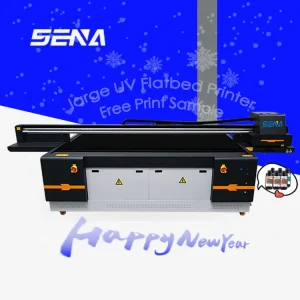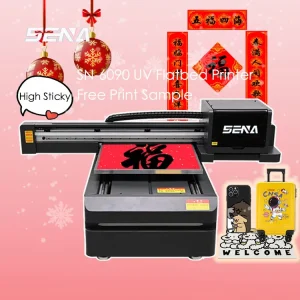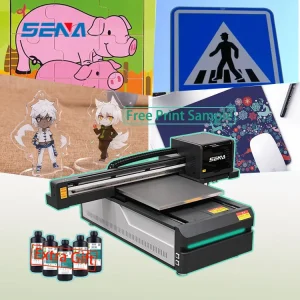Αποφύγετε το ερώτημά σας είναι καθυστέρηση απάντησης, εισάγετε το WhatsApp/WeChat/Skype μαζί με το μήνυμα, ώστε να μπορούμε να επικοινωνήσουμε μαζί σας την πρώτη κιόλας φορά
Θα σας απαντήσουμε εντός 24 ωρών. Εάν πρόκειται για επείγουσα περίπτωση, προσθέστε το WhatsApp: +86 17864107808, ή WeChat: +86 17864107808. Ή καλέστε +86 17864107808 κατευθείαν.
*Σεβόμαστε την εμπιστευτικότητά σας και όλες οι πληροφορίες προστατεύονται. Θα χρησιμοποιήσουμε τα στοιχεία σας μόνο για να απαντήσουμε στο ερώτημά σας και δεν θα στείλουμε ποτέ ανεπιθύμητα μηνύματα ηλεκτρονικού ταχυδρομείου ή διαφημιστικά μηνύματα.
Με την ταχεία ανάπτυξη της επιστήμης και της τεχνολογίας, η τεχνολογία ψηφιακής εκτύπωσης επίσης διασχίζει συνεχώς και καινοτομεί. Τα τελευταία χρόνια, οι εκτυπωτές επίπεδης επιφάνειας UV ξεχωρίζουν στον κλάδο της εκτύπωσης με τα χαρακτηριστικά υψηλής ακρίβειας, υψηλής απόδοσης, προστασίας του περιβάλλοντος και εξοικονόμησης ενέργειας. Πρόσφατα, Τεχνολογία UV επίπεδης επιφάνειας εκτυπωτή έκανε για άλλη μια φορά μια σημαντική ανακάλυψη και υλοποίησε με επιτυχία την τρισδιάστατη ανακούφιση τρισδιάστατη εκτύπωση, η οποία έφερε νέες ευκαιρίες ανάπτυξης για τον κλάδο της εκτύπωσης. Αυτή η εργασία θα παρουσιάσει λεπτομερώς το υπόβαθρο, την αρχή, το πεδίο εφαρμογής και την προοπτική της αγοράς της ανακάλυψης της τεχνολογίας των εκτυπωτών επίπεδης επιφάνειας UV, προκειμένου να παράσχει στους αναγνώστες μια ολοκληρωμένη και σε βάθος κατανόηση.

1. Προέλευση και ανάπτυξη του Εκτυπωτής επίπεδης επιφάνειας UV
Ο εκτυπωτής επίπεδης επιφάνειας UV είναι ένα είδος εκτυπωτή inkjet που χρησιμοποιεί τεχνολογία υπεριώδους σκλήρυνσης, ο οποίος μπορεί να εκτυπώσει σε διάφορα επίπεδα, καμπύλα και ακανόνιστου σχήματος υλικά με υψηλή ακρίβεια. Από την εμφάνιση του πρώτου εκτυπωτή επίπεδης επιφάνειας UV το 2003, η τεχνολογία γνώρισε μια ταχεία διαδικασία ανάπτυξης από την αρχή, από τη χαμηλή έως την προηγμένη τεχνολογία, από μία εφαρμογή έως τη ευρεία δημοτικότητα. Σήμερα, οι εκτυπωτές επίπεδης επιφάνειας υπεριώδους ακτινοβολίας έχουν γίνει ένας από τους σημαντικότερους εξοπλισμούς στη βιομηχανία εκτύπωσης, που χρησιμοποιούνται ευρέως στη διαφήμιση, τη συσκευασία, τη διακόσμηση, την αναπαραγωγή τέχνης και άλλους τομείς.
2. Η διαφορά μεταξύ εκτυπωτή επίπεδης επιφάνειας UV και εκτυπωτή inkjet
Υπάρχουν σημαντικές διαφορές μεταξύ των εκτυπωτών επίπεδης επιφάνειας UV και των παραδοσιακών εκτυπωτών inkjet από πολλές απόψεις. Πρώτα απ 'όλα, οι εκτυπωτές επίπεδης επιφάνειας UV χρησιμοποιούν τεχνολογία υπεριώδους σκλήρυνσης, η οποία μπορεί να στεγνώσει το μελάνι σε μια στιγμή, βελτιώνοντας σημαντικά την απόδοση παραγωγής. Οι παραδοσιακοί εκτυπωτές inkjet απαιτούν μεγαλύτερη φυσική διαδικασία στεγνώματος ή ψησίματος. Δεύτερον, ο εκτυπωτής επίπεδης επιφάνειας UV έχει υψηλότερη ακρίβεια και ανάλυση εκτύπωσης, γεγονός που μπορεί να παρουσιάσει ένα πιο λεπτό και ρεαλιστικό εφέ εικόνας. Επιπλέον, οι εκτυπωτές επίπεδης επιφάνειας UV υποστηρίζουν επίσης την εκτύπωση διαφόρων υλικών, όπως ξύλο, μέταλλο, γυαλί, κεραμικά κ.λπ., με μεγάλη ευελιξία και ευελιξία. Οι παραδοσιακοί εκτυπωτές inkjet είναι κυρίως κατάλληλοι για την εκτύπωση μαλακών υλικών όπως το χαρτί.
1. Η αρχή της τρισδιάστατης ανάγλυφης εκτύπωσης
Η τρισδιάστατη ανάγλυφη εκτύπωση είναι ένα είδος μεθόδου εκτύπωσης που σχηματίζει ένα τρισδιάστατο σχέδιο ή κείμενο στην επιφάνεια ενός υλικού μέσω της τεχνολογίας ψηφιακής εκτύπωσης. Η αρχή είναι να χρησιμοποιείτε το ακροφύσιο του εκτυπωτή με επίπεδη επιφάνεια UV για να ψεκάζετε το μελάνι UV στην επιφάνεια του υλικού σύμφωνα με ένα προκαθορισμένο σχέδιο ή τροχιά κειμένου και, στη συνέχεια, το μελάνι στεγνώνει γρήγορα και στερεώνεται στο υλικό μέσω τεχνολογίας υπεριώδους σκλήρυνσης. Επειδή το ύψος συσσώρευσης και το σχήμα του μελανιού UV μπορούν να ρυθμιστούν σύμφωνα με το προκαθορισμένο μοτίβο ή κείμενο, μπορεί να σχηματίσει ένα τρισδιάστατο ανάγλυφο εφέ στην επιφάνεια του υλικού.
2. Τα τεχνικά πλεονεκτήματα του UV flatbed εκτυπωτή στην τρισδιάστατη ανάγλυφη εκτύπωση
Οι εκτυπωτές επίπεδης επιφάνειας UV έχουν σημαντικά τεχνικά πλεονεκτήματα στην τρισδιάστατη ανάγλυφη εκτύπωση. Πρώτα απ 'όλα, ο εκτυπωτής επίπεδης επιφάνειας UV χρησιμοποιεί ένα ακροφύσιο υψηλής ακρίβειας, το οποίο μπορεί να ελέγξει με ακρίβεια την ποσότητα και τη θέση της έγχυσης μελανιού, έτσι ώστε να επιτευχθεί ένα λεπτό αποτέλεσμα ανακούφισης. Δεύτερον, το μελάνι UV έχει καλή πρόσφυση και ανθεκτικότητα και μπορεί να σχηματίσει ένα σταθερό στρώμα εκτύπωσης σε διάφορα υλικά, το οποίο δεν είναι εύκολο να πέσει ή να ξεθωριάσει. Επιπλέον, ο εκτυπωτής επίπεδης επιφάνειας UV υποστηρίζει επίσης την εκτύπωση ποικιλίας υλικών, συμπεριλαμβανομένων σκληρών υλικών όπως ξύλο, μέταλλο, γυαλί, καθώς και μαλακών υλικών όπως ύφασμα και δέρμα, τα οποία έχουν μεγάλη ευελιξία και ευελιξία.
3. Η διαδικασία υλοποίησης της τρισδιάστατης ανάγλυφης εκτύπωσης
Η διαδικασία υλοποίησης της τρισδιάστατης ανάγλυφης εκτύπωσης περιλαμβάνει κυρίως τα ακόλουθα βήματα: Πρώτον, τη χρήση επαγγελματικού λογισμικού σχεδιασμού σύμφωνα με τις ανάγκες του πελάτη για το σχεδιασμό ενός τρισδιάστατου σχεδίου ή κειμένου. Δεύτερον, το σχεδιασμένο μοτίβο ή κείμενο εισάγεται στο λογισμικό ελέγχου του εκτυπωτή επίπεδης επιφάνειας UV και ρυθμίζονται οι παράμετροι εκτύπωσης. Στη συνέχεια, το προς εκτύπωση υλικό τοποθετείται στην πλατφόρμα εκτύπωσης και ο εκτυπωτής ξεκινά για εκτύπωση. Τέλος, μετά την ολοκλήρωση της εκτύπωσης, το υλικό αφαιρείται από την πλατφόρμα εκτύπωσης και μπορεί να ληφθεί η απαραίτητη μετεπεξεργασία (όπως κοπή, ντύσιμο κ.λπ.) με τρισδιάστατες ανάγλυφες εργασίες.

1. Εξατομικευμένη διακόσμηση και αναπαραγωγή έργων τέχνης
Η τεχνολογία τρισδιάστατης ανάγλυφης εκτύπωσης με επίπεδη επιφάνεια UV έχει ένα ευρύ φάσμα προοπτικών εφαρμογής στον τομέα της εξατομικευμένης διακόσμησης και της αναπαραγωγής έργων τέχνης. Μέσω αυτής της τεχνολογίας, μια ποικιλία τρισδιάστατων μοτίβων ή κειμένου μπορούν εύκολα να εκτυπωθούν, όπως τοιχογραφίες, τοιχογραφίες, αντίγραφα γλυπτών κ.λπ. Αυτά τα έργα όχι μόνο έχουν μοναδική καλλιτεχνική ομορφιά, αλλά μπορούν επίσης να καλύψουν τις ατομικές ανάγκες των πελατών. είναι ευρέως ευπρόσδεκτα στον τομέα της διακόσμησης σπιτιού, της εμπορικής προβολής και ούτω καθεξής.
2. Βιομηχανικός σχεδιασμός και πρωτοτυποποίηση
Στον τομέα του βιομηχανικού σχεδιασμού και της δημιουργίας πρωτοτύπων, η τεχνολογία τρισδιάστατης εκτύπωσης με επίπεδη οθόνη UV έχει επίσης μεγάλες δυνατότητες εφαρμογής. Με αυτήν την τεχνολογία, οι σχεδιαστές μπορούν γρήγορα να δημιουργήσουν τρισδιάστατα μοντέλα ή πρωτότυπα για προβολή, δοκιμή ή αξιολόγηση πριν από την παραγωγή. Αυτό όχι μόνο βελτιώνει σημαντικά την αποδοτικότητα του σχεδιασμού, αλλά και μειώνει το κόστος παραγωγής.
3. Βιομηχανία συσκευασίας και επισήμανσης
Στη βιομηχανία συσκευασίας και ετικετών, η τεχνολογία τρισδιάστατης ανάγλυφης εκτύπωσης με επίπεδη οθόνη UV έχει φέρει νέα δημιουργικότητα και δυνατότητες στη συσκευασία των προϊόντων. Μέσω αυτής της τεχνολογίας, ένα τρισδιάστατο μοτίβο ή κείμενο μπορεί να εκτυπωθεί στο υλικό συσκευασίας, όπως ταυτότητα επωνυμίας, πληροφορίες προϊόντος κ.λπ. Αυτές οι τρισδιάστατες συσκευασίες μπορούν όχι μόνο να προσελκύσουν την προσοχή των καταναλωτών, αλλά και να βελτιώσουν την ποιότητα και την εικόνα του προϊόντος.
4. Εκπαίδευση και έρευνα
Στον τομέα της εκπαίδευσης και της επιστημονικής έρευνας, η τεχνολογία τρισδιάστατης εκτύπωσης με επίπεδη οθόνη UV διαδραματίζει επίσης σημαντικό ρόλο. Μέσω αυτής της τεχνολογίας, μπορούν να κατασκευαστούν διάφορα μοντέλα διδασκαλίας, πειραματικός εξοπλισμός και άλλος εξοπλισμός διδασκαλίας για το AIDS ή επιστημονική έρευνα. Αυτά τα διδακτικά AIDS ή εξοπλισμός όχι μόνο έχουν τα χαρακτηριστικά της διαίσθησης και της εικόνας, αλλά μπορούν επίσης να βοηθήσουν τους μαθητές να κατανοήσουν καλύτερα και να κατακτήσουν τη σχετική γνώση.
1. Ανάλυση προοπτικής αγοράς
Με την αυξανόμενη ζήτηση των καταναλωτών για εξατομικευμένα προϊόντα υψηλής ποιότητας, καθώς και την άνοδο εννοιών όπως η βιομηχανία 4.0 και η έξυπνη κατασκευή, η τεχνολογία εκτύπωσης 3D με επίπεδη οθόνη UV θα οδηγήσει σε μια ευρύτερη προοπτική της αγοράς. Η τεχνολογία θα παίξει σημαντικό ρόλο σε πολλούς τομείς, όπως η εξατομικευμένη διακόσμηση, η αναπαραγωγή έργων τέχνης, ο βιομηχανικός σχεδιασμός και η κατασκευή πρωτοτύπων, η συσκευασία και η επισήμανση. Ταυτόχρονα, με τη συνεχή πρόοδο της τεχνολογίας και τη μείωση του κόστους, η τεχνολογία τρισδιάστατης ανάγλυφης εκτύπωσης με επίπεδη οθόνη UV θα επεκτείνει περαιτέρω το πεδίο εφαρμογής και τον χώρο της αγοράς.
2. Προκλήσεις που αντιμετωπίζονται και στρατηγικές αντιμετώπισης
Αν και η τεχνολογία τρισδιάστατης ανάγλυφης εκτύπωσης του εκτυπωτή με επίπεδη επιφάνεια UV έχει ευρείες προοπτικές αγοράς, εξακολουθεί να αντιμετωπίζει ορισμένες προκλήσεις στην πρακτική διαδικασία εφαρμογής. Για παράδειγμα, πώς να βελτιώσετε περαιτέρω την ακρίβεια και την ταχύτητα εκτύπωσης για να καλύψετε τις ανάγκες της μαζικής παραγωγής. Πώς να μειώσετε το κόστος εκτύπωσης για τη βελτίωση της ανταγωνιστικότητας στην αγορά. Πώς να λύσετε το πρόβλημα συμβατότητας μεταξύ διαφορετικών υλικών. Ως απάντηση σε αυτές τις προκλήσεις, μπορούν να υιοθετηθούν οι ακόλουθες στρατηγικές: πρώτον, ενίσχυση της τεχνολογικής έρευνας και ανάπτυξης και καινοτομίας και συνεχής βελτίωση της ακρίβειας και της ταχύτητας εκτύπωσης. Το δεύτερο είναι η βελτιστοποίηση της διαδικασίας παραγωγής και της ροής για τη μείωση του κόστους εκτύπωσης. Το τρίτο είναι να ενισχυθεί η έρευνα και ανάπτυξη υλικών και η έρευνα εφαρμογών για τη βελτίωση της συμβατότητας μεταξύ διαφορετικών υλικών.

Η καινοτομία της τεχνολογίας εκτυπωτών επίπεδης επιφάνειας UV για την επίτευξη τρισδιάστατης εκτύπωσης ανακούφισης 3D έχει φέρει νέες ευκαιρίες ανάπτυξης και προκλήσεις στον κλάδο της εκτύπωσης. Μέσω αυτής της τεχνολογίας, μια ποικιλία τρισδιάστατων μοτίβων ή κειμένου μπορούν εύκολα να εκτυπωθούν για να καλύψουν τις ατομικές ανάγκες των καταναλωτών. Ταυτόχρονα, αυτή η τεχνολογία έχει επίσης ένα ευρύ φάσμα πεδίων εφαρμογής και προοπτικές αγοράς. Ωστόσο, ορισμένες προκλήσεις και προβλήματα πρέπει ακόμη να αντιμετωπιστούν στην πρακτική διαδικασία εφαρμογής. Ως εκ τούτου, πρέπει να ενισχύουμε συνεχώς την τεχνολογική έρευνα και ανάπτυξη και καινοτομία, να βελτιστοποιούμε τις διαδικασίες και τις διαδικασίες παραγωγής και να βελτιώνουμε τη συμβατότητα μεταξύ διαφορετικών υλικών για να προωθήσουμε την περαιτέρω ανάπτυξη και εφαρμογή της τεχνολογίας τρισδιάστατης ανάγλυφης εκτύπωσης για εκτυπωτές επίπεδης επιφάνειας UV. Πιστεύεται ότι στο εγγύς μέλλον, η τεχνολογία θα παίξει σημαντικό ρόλο σε περισσότερους τομείς, φέρνοντας περισσότερες εκπλήξεις και ομορφιά στη ζωή μας.